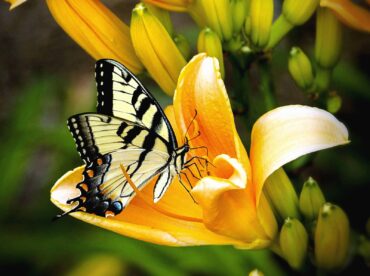 You water, you prune, you fertilize. But you can’t pollinate. Pollination is essential for a beautiful garden, but it’s also important in the bigger picture of ecology. By welcoming pollinators to your backyard, you’re inviting them to stay in the area and support our apple and cherry trees and genetic diversity.
You water, you prune, you fertilize. But you can’t pollinate. Pollination is essential for a beautiful garden, but it’s also important in the bigger picture of ecology. By welcoming pollinators to your backyard, you’re inviting them to stay in the area and support our apple and cherry trees and genetic diversity.
While wasps will pollinate your plants, they have stingers, and a group of them can get angry when surprised during their meal. You can encourage many other winged creatures to get the job done by installing native plants.
To be sure you have a variety of pollinators, you’ll want a variety of plants. Here in West Sound, you should look for plants that fall in the USDA Hardiness zone of 8-9.
Here’s a rundown of five safe pollinators you can invite to your backyard buffet.
1. Butterflies
Everyone loves to admire the beautiful colors and delicate flight of butterflies. While moving pollen is not a butterfly’s intention, they happen to be pretty good at it. Due to habitat loss, more than a dozen butterfly species currently rank on Washington state’s endangered species list. By incorporating butterfly-friendly plants in your garden, you’ll be doing a double service to the local environment.
Inviting elements: Bright colors; flower clusters; flat petal formations
Favorite plants: Dogwoods, asters, violets, Joe Pye weed
2. Hummingbirds
Instead of a hummingbird feeder dripping sugar water all over your deck, give them some fresh nectar to nosh on. Like butterflies, hummingbirds are accidental pollinators. Weighing around 4 grams (a penny weighs 3), hummingbirds drink twice their weight each day. Hummingbirds will move pollen as they belly up to all these different flowers during the day.
Inviting elements: Long, tubular flowers; bright colors including red
Favorite plants: Hardy fuchsia, delphinium, bee balm, lilies
3. Moths
Perhaps a surprise, moths have recently been acknowledged as important players in the world of pollination. Moths get less respect than their butterfly cousins, but with tongues longer than their bodies and wingspans approaching 5 inches, hawk moths can access pollen the other guys can’t. Though hawk moths aren’t going to win a beauty contest any time soon, they are terrific, safe pollinators.
Inviting elements: White or dull colors; flower clusters
Favorite plants: Jimson weed, four o’clock flowers, roses
4. Beetles
Less fun to watch than hummingbirds and butterflies, beetles also don’t get the credit they deserve. With some 30,000 species in the United States, beetles are ancient pollinators. Known as “mess and soil” pollinators, they move pollen through their digestive system.
Inviting elements: Bowl-shaped; white and dull green; solitary or cluster growth
Favorite plants: Goldenrod, trillium, buttercups
5. Bumblebees
With bodies designed especially for moving pollen, the humble bumble has no match (pdf) when it comes to effective pollinating. One reason? Bees have the ability to generate body heat. This allows them to continue working when other insects must call it quits.
Like wasps, bees have stingers. The good news is that bumblebees rarely sting. When you’re confronted with a worker bee, just stand still and wait for her to move on. Bumblebees only sting when provoked.
Inviting elements: Blue, purple, pink, yellow; perennial plants
Favorite plants: Ornamental grass, yarrow, penstemon, catmint
Design a Smorgasbord
If you’re looking to put in some new plants and see who shows up, start with yarrow, penstemon, catmint, bee balm, delphinium and hardy fuchsia.
By installing a pollinator-friendly buffet, you can sit back and see who comes to dine. You can also rest assured knowing you’re doing something to support our community’s ecology.


























